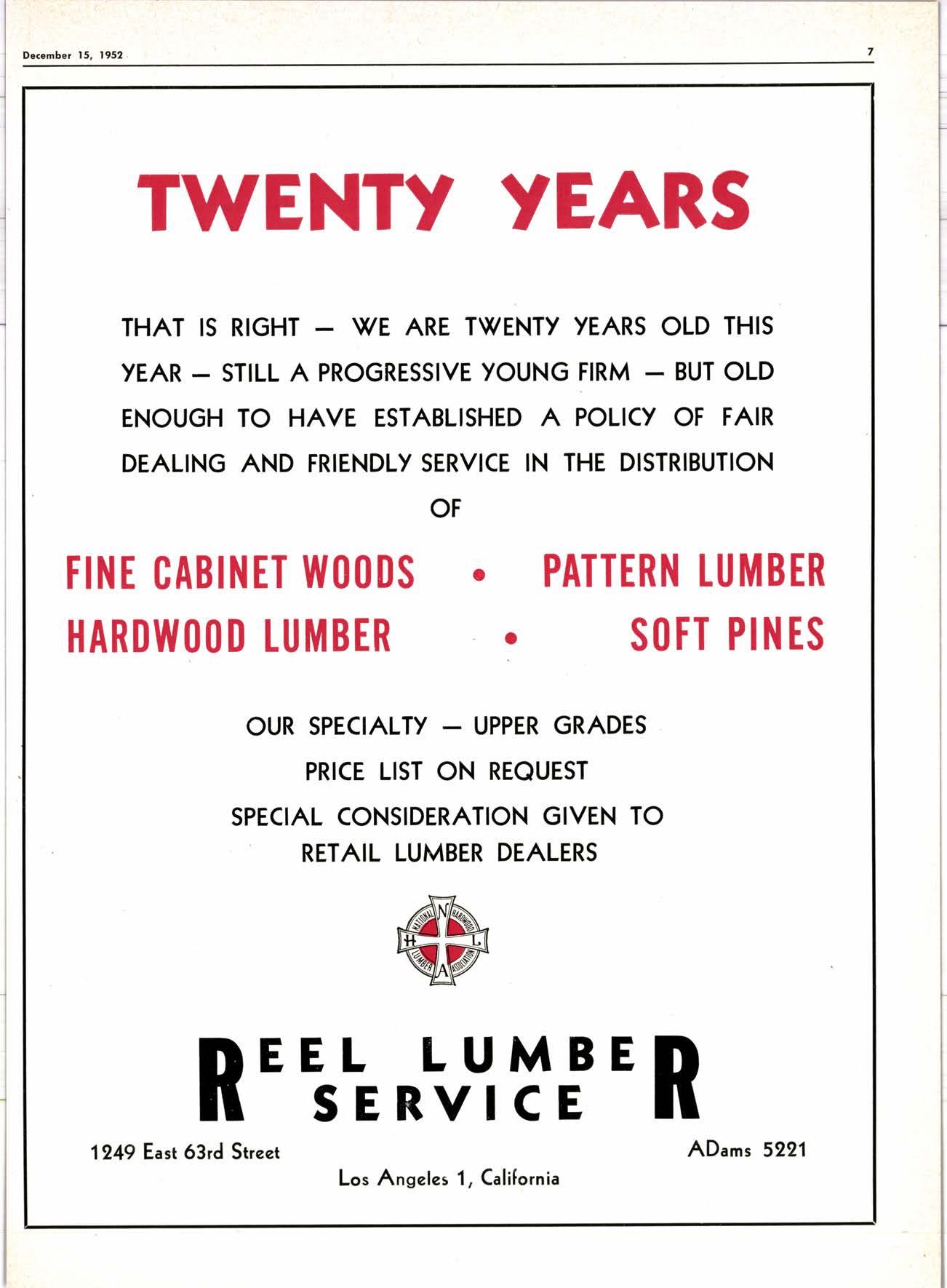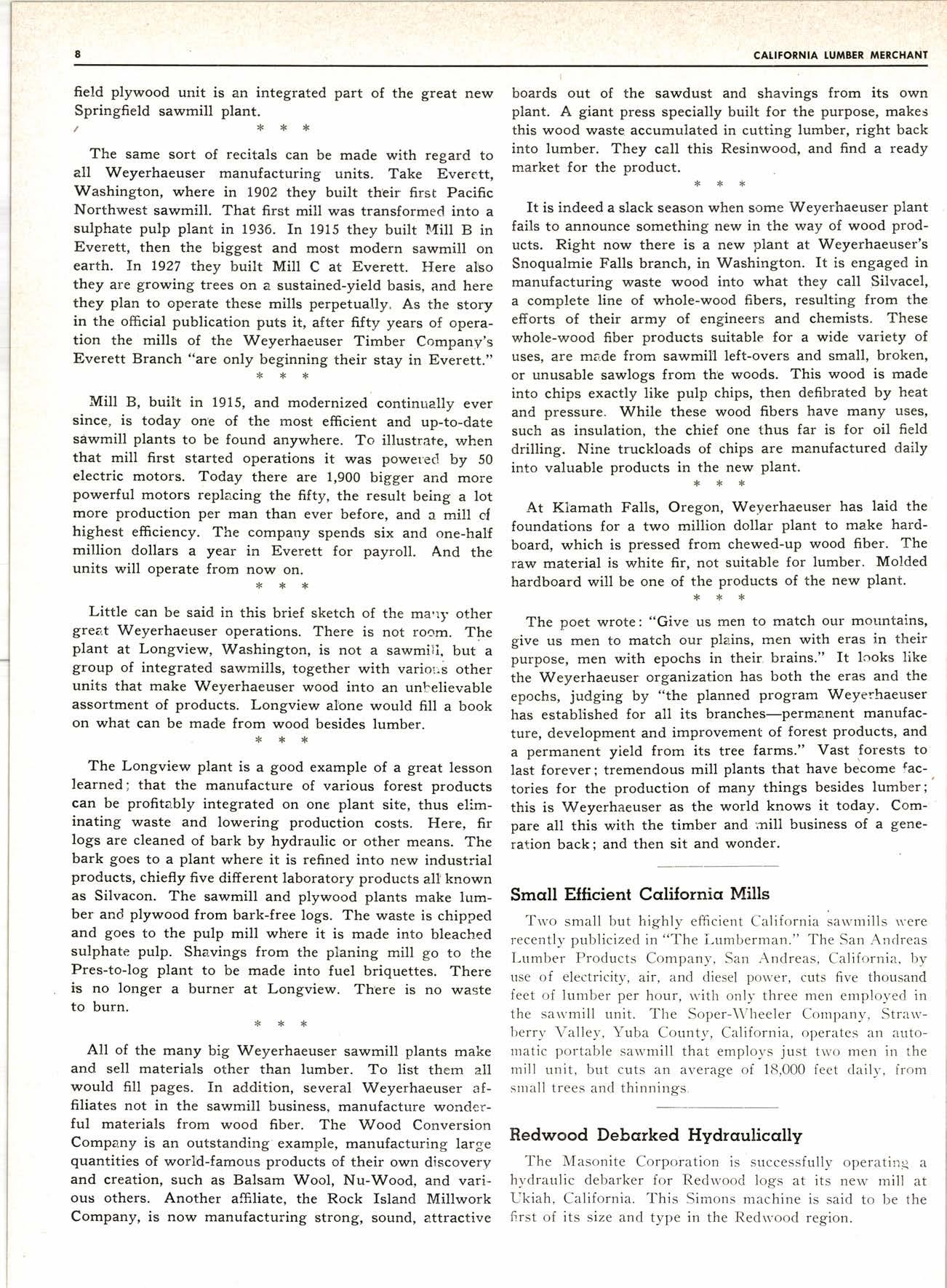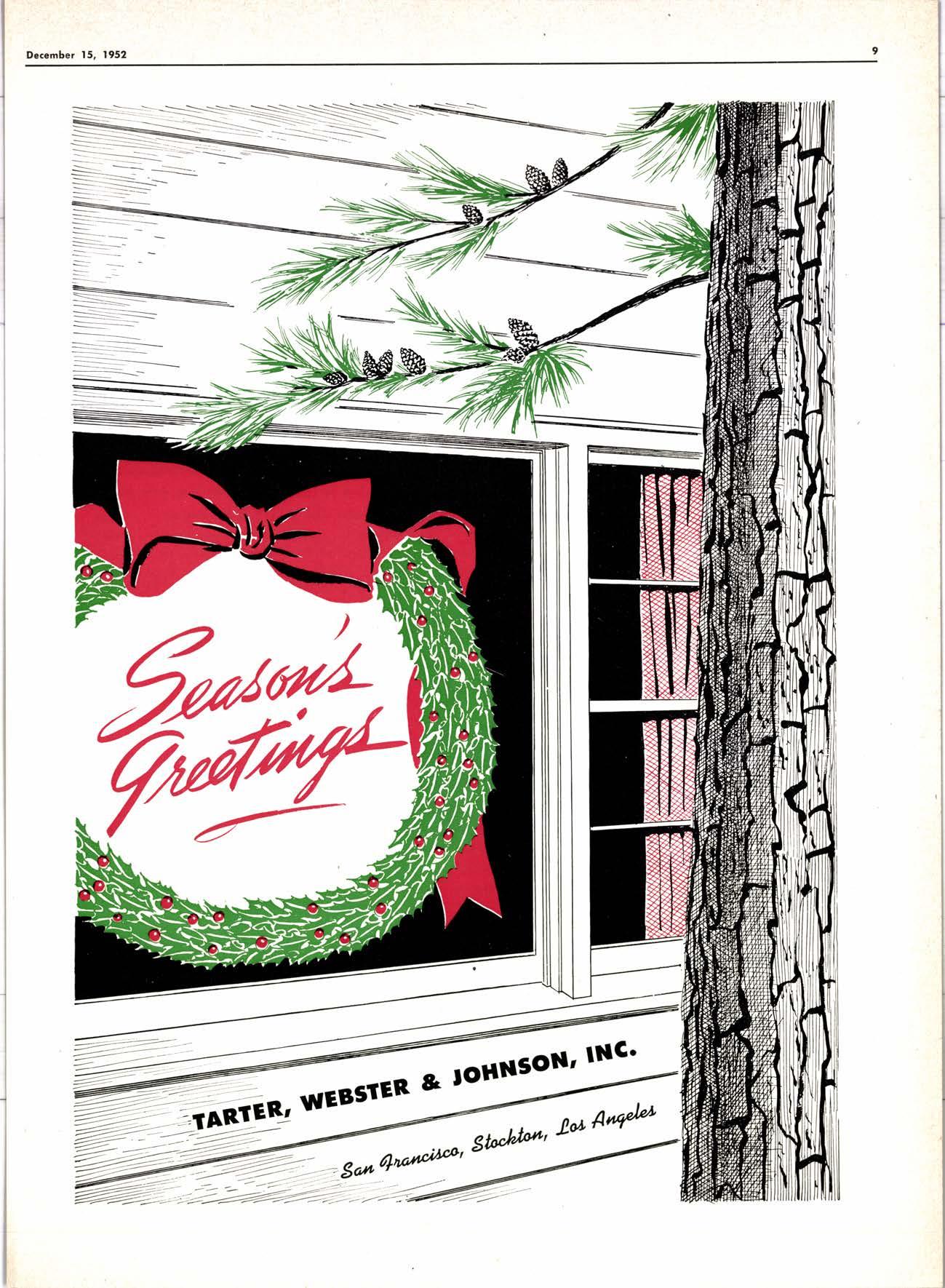
4 minute read
TWENTY YEARS
THAT IS RIGHT \(/E ARE T\(/ENTY YEARS OLD THIS YEAR - STILL A PROGRESSIVE YOUNG FIRM - BUT OLD ENOUGH TO HAVE ESTABLISHED A POLICY OF FAIR
DEALING AND FRIENDLY SERVICE IN THE DISTRIBUTION
PATTERN LUMBER
S(|FT PI N ES
PRICE LIST ON REOUEST
EEL SE LUM BE E R ADams RVIC 1249 East 63rd Street Los Angeles 1, California 5221 field plywood unit is an integrated part of the great new Springfield sawmill plant.
The same sort of recitals can be made with regard to all Weyerhaeuser manufacturing units. Take Evere.tt, Washington, where in 1902 they built th'eir first Pacific Northwest sawmill. That first mill was transformed into a sulphate pulp plant in 1936. In 1915 they built tr{ill B in Everett, then the biggest and most modern sawmill on earth. In 1927 they built Mill C at Everett. Here also they are growing trees on a sustained-yield basis, and here they plan to operate these mills perpetually. As the story in the official publication puts it, after fifty years of operation the'mills of the Weyerhaeuser Timber Company's Everett Branch "are only beginning their stay in Everett."

Mill B, buitt in 1915, and modernized continually ever since, is today one of the most efficient and up-to-date sawmill plants to be found anywhere. To illustrate, when that mill first started operations it was powered by 50 electric motors. Today there are 1,900 bigger and more powerful motors replacing the fifty, the result being a lot more production per man than ever before, and a mill ol highest efficiency. The company spends six and one-half million dollars a year in Everett for payroll. And the units will operate tto- r:*
Little can be said in this brief sketch of the marr)' other great Weyerhaeuser operations. There is not room. The plant at Longview, Washington, is not a sawmill. but a group of integrated sawmills, together with varior.s other units that make Weyerhaeuser wood into an unbelievable assortment of products. Longview alone would fill a book on what can be made from wood besides lumber-
The Longview plant is a good example of a great lesson learned; that the manufacture of various forest products can be profitably integrated on one plant site, thus eli.minating waste and lowering production costs. Ilere, fir logs are cleaned of bark by hydraulic or other means. The bark goes to a plant where it is refined into new industrial products, chiefy five different laboratory products all known as Silvacon. The sawmill and plywood plants make lumber and plywood from bark-free logs. The waste is chipped and goes to the pulp mill where it is made into bleached sulphate pulp. Shavings from the planing mill go to the Pres-to-log plant to be made into fuel briquettes. There is no longer a burner at Longview. There is no waste to burn'
All of the many big Weyerhaeuser sawmill plants make and sell materials other than lumber. To list them all would fill pages. In addition, several Weyerhaeuser affiliates not in the sawmill business, manufacture wonderful materials from wood fiber. The Wood Conversion Company is an outstanding example, manufacturing large quantities of world-famous products of their own discovery and creation, such as Balsam Wool, Nu-Wood, and various others. Another affiliate. the Rock Island Millwork Company, is now manufacturing strong, sound, attractive boards out of the sawdust and shavings from its own plant. A giant press specially built for the purpose, makes this wood waste accumulated in cutting lumber, right back into lumber. They call this Resinwood, and find a ready market for the product.
It is indeed a slack season when some Weyerhaeuser plant fails to announce something new in the way of wood products. Right now there is a new plant at Weyerhaeuser's Snoqualmie Falls branch, in Washington. It is engaged in manufacturing waste wood into what they call Silvacel, a complete line of whole-wood fibers, resulting from the efforts of their army of engineers and chemists. These whole-wood fiber products suitable for a wide variety of uses, are made from sawmill left-overs and small, broken, or unusable sawlogs from the woods. This wood is made into chips exactly like pulp chips, then defibrated by heat and pressure. While these wood fibers have many uses' such as insulation, the chief one thus far is for oil field drilling. Nine truckloads of chips are manufactured daily into valuable products tt *an.* new plant.
At Klamath Falls, Oregon, Weyerhaeuser has laid the foundations for a two million dollar plant to make hardboard, which is pressed from chewed-up wood fiber. The raw material is white fir, not suitable for lumber. Molded hardboard will be one of the;rrlducts of the new plant.
The poet wrote: "Give us men to match our mountains, give us men to match our plains, men with eras in their purpose, men with epochs in their, brains." It looks like the Weyerhaeuser organization has both the eras and the epochs, judging by "the planned program Weyerhaeuser has established for all its branches-permanent manufacture, development and improvement of forest products, and a permanent yield from its tree farms." Vast forests to last forever; tremendous mill plants that have become factories for the production of many things besides lumber; this is Weyerhaeuser as the world knows it today. Compare all this with the timber and srill business of a generation back: and then sit and wonder.
Small Elficient Ccrlilorniq Mills
Trvo small but highly efificient California sawmills n'ere recently publicized in "The i,umberman." The San Andreas Lumber Products Company, San Andreas, California, by use of electricity, air, and diesel power, cuts five thousand feet of lumber per hour, with only three men employed in the sawmill unit. The Soper-Wheeler Company, Strarvberry Valley, Yuba County, California, operates an autornatic portable sarvmill that employs just tr,vo men in the mill unit, but cuts an average of 18,0O0 feet daily, from snrall trees and thinnings
Bedwood Debcrked Hydrculiccrlly
The Masonite Corporation is successfully operating a hydraulic debarker for Redwood logs at its new mill at Ukiah, California. This Simons machine is said to be the first of its size and type in the Redrvood region.











